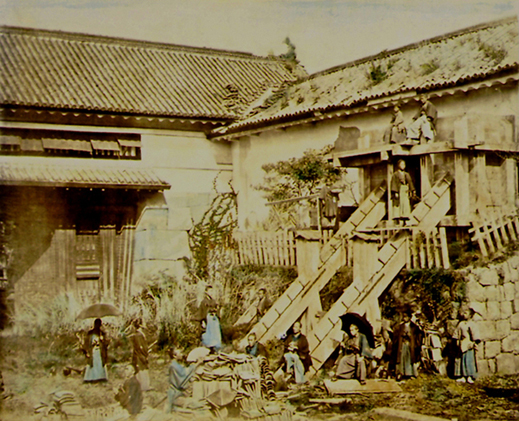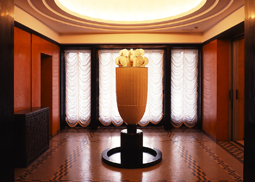 |
Here and There introduces art, artists, galleries and museums around Japan that non-Japanese readers and first-time visitors may find of particular interest. The writer claims no art expertise, just a subjective viewpoint acquired over many years' residence in Japan. |
|
 |
|
|
 |
 |
Art Deco Palaces and Ruined Castles: The Tokyo Metropolitan Teien Art Museum
Alan Gleason |
 |
 |
|
Edo Castle, 1871 (Albumen print), photographed by Matsusaburo Yokoyama
Property of Kasumi Kaikan, Foundation for Community Services
Image courtesy of the Tokyo Metropolitan Teien Art Museum.
|
Tokyo's history of dramatic political transformations -- first into Edo, the seat of the Tokugawa Shogunate and then, in 1868, into the new imperial capital -- has blessed it with a number of large green spaces that were once the estates of feudal lords and subsequently of various imperial princes and princesses. When another upheaval came with defeat in World War II and the dismantling of the aristocracy, most of these estates were converted into city parks. In some cases the residences of the nobility remain; since most were built in the past hundred years or so they are modern, sturdy edifices of concrete that have withstood earthquakes and air raids with aplomb.
One outstanding example is the former residence of Prince Asaka, a tasteful Art Deco mansion built in Meguro in 1933 with input from the French designer Henri Rapin. After the war the building and its grounds were snapped up by a business conglomerate, but eventually the Tokyo government purchased the property and converted it into a museum in 1983. The Tokyo Metropolitan Teien Art Museum still looks out on the original gardens and is surrounded by a large nature preserve, the National Institute for Nature Study. Together they make quite a nice little oasis in the middle of Tokyo.
The interior of the museum, a paean to Art Deco in its prime, perfectly complements the exhibit on its walls until March 31. "Remembrance of Places Past" is a retrospective of Japanese architectural photography since the advent of the camera in the mid-1800s, which coincided with the fall of the Shogunate. The camera lens thus provides a timely and fascinating window into the historical upheavals of that era. The earliest shots are of the great castles of the Shogunate and its fiefdoms, including Edo Castle itself, taken just a few years after the Shogun's forces had been routed by the royalists. It is astonishing to see how quickly these grand structures, now abandoned, have fallen into disrepair. Indeed, the impetus for many of these images was the photographers' desire to capture the grandeur of the castles before they collapsed completely.
The exhibit takes us on into the prewar modernist period, which produced a number of attractive Bauhaus-inspired residences for the nobility and the wealthy. Unfortunately the postwar period is represented by the bleak, boxy, raw concrete structures of architects like Kenzo Tange, who, though best known for the soaring curves of his Olympic Gymnasium, also created the Hiroshima Peace Memorial Museum, a shoebox on stilts. Poignant contrast is offered by a roomful of photos of the Katsura Imperial Villa in Kyoto, a 17th-century gem whose low-slung perpendicular lines in natural hues of slate, wood and paper prove that right angles can be beautiful after all.
Complemented by the warm wooden fixtures and softly lit curves of the museum interior itself, this remarkable collection of photos offers some profound aesthetic insights into modern Japanese history.
|
|
|
|
|
|
 |
|
|
|
The former Prince Asaka residence in Meguro, now the Tokyo Metropolitan Teien Art Museum.
Photo by Alan Gleason |
|
Water fountain in the anteroom of the Tokyo Metropolitan Teien Art Museum.
Image courtesy of
the Tokyo Metropolitan Teien Art Museum. |
|
|
|
|
|
 |
Remembrance of Places Past: Japanese Architectural Photography from the 19th to the 21st Century (until 31 March 2008) |
 |
|
 |
Tokyo Metropolitan Teien Art Museum |
 |
|
 |
21-9 Shirokanedai 5-chome, Minato-ku, Tokyo |
|
Phone: 03-3443-0201
Open 10-6 (Closed on the 2nd and 4th Wednesdays of the month and the new year holidays)
Transportation: 7 minutes walk from JR Meguro station on the Yamanote Line, or 6 minutes walk from Shirokanedai station on the Metro Nanboku Line |
 |
|
 |
 |
Alan Gleason
Alan Gleason is a translator, editor and writer based in Tokyo, where he has lived for 24 years. In addition to writing about the Japanese art scene he has edited and translated works on Japanese theater (from kabuki to the avant-garde) and music (both traditional and contemporary). |
|
|
|
 |
 |
|
|